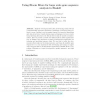Free Online Productivity Tools
i2Speak
i2Symbol
i2OCR
iTex2Img
iWeb2Print
iWeb2Shot
i2Type
iPdf2Split
iPdf2Merge
i2Bopomofo
i2Arabic
i2Style
i2Image
i2PDF
iLatex2Rtf
Sci2ools
156
click to vote
PADL
2009
Springer
2009
Springer
Using Bloom Filters for Large Scale Gene Sequence Analysis in Haskell
Analysis of biological data often involves large data sets and computationally expensive algorithms. Databases of biological data continue to grow, leading to an increasing demand for improved algorithms and data structures. Despite having many advantages over more traditional indexing structures, the Bloom filter is almost unused in bioinformatics. Here we present a robust and efficient Bloom filter implementation in Haskell, and implement a simple bioinformatics application for indexing and matching sequence data. We use this to index the chromosomes that make up the human genome, and map all available gene sequences to it. Our experiences with developing and tuning our application suggest that for bioinformatics applications, Haskell offers a compelling combination of rapid development, quality assurance, and high performance.
Biological Data | Efficient Bloom Filter | PADL 2009 | Programming Languages | Simple Bioinformatics Application |
Related Content
| Added | 22 Nov 2009 |
| Updated | 22 Nov 2009 |
| Type | Conference |
| Year | 2009 |
| Where | PADL |
| Authors | Ketil Malde, Bryan O'Sullivan |
Comments (0)

